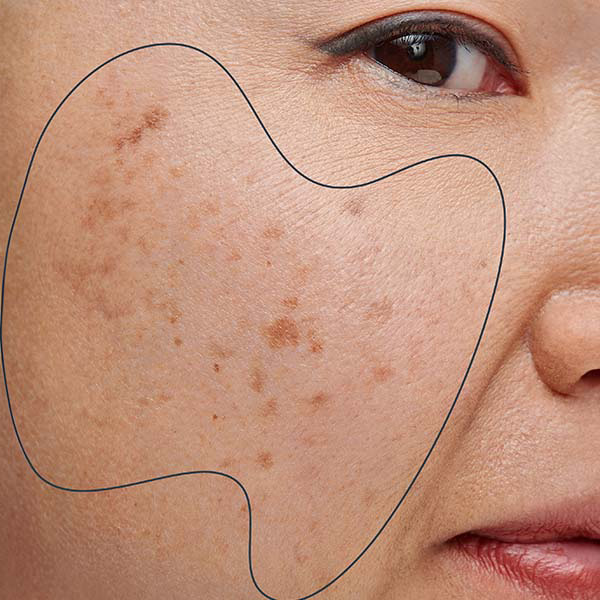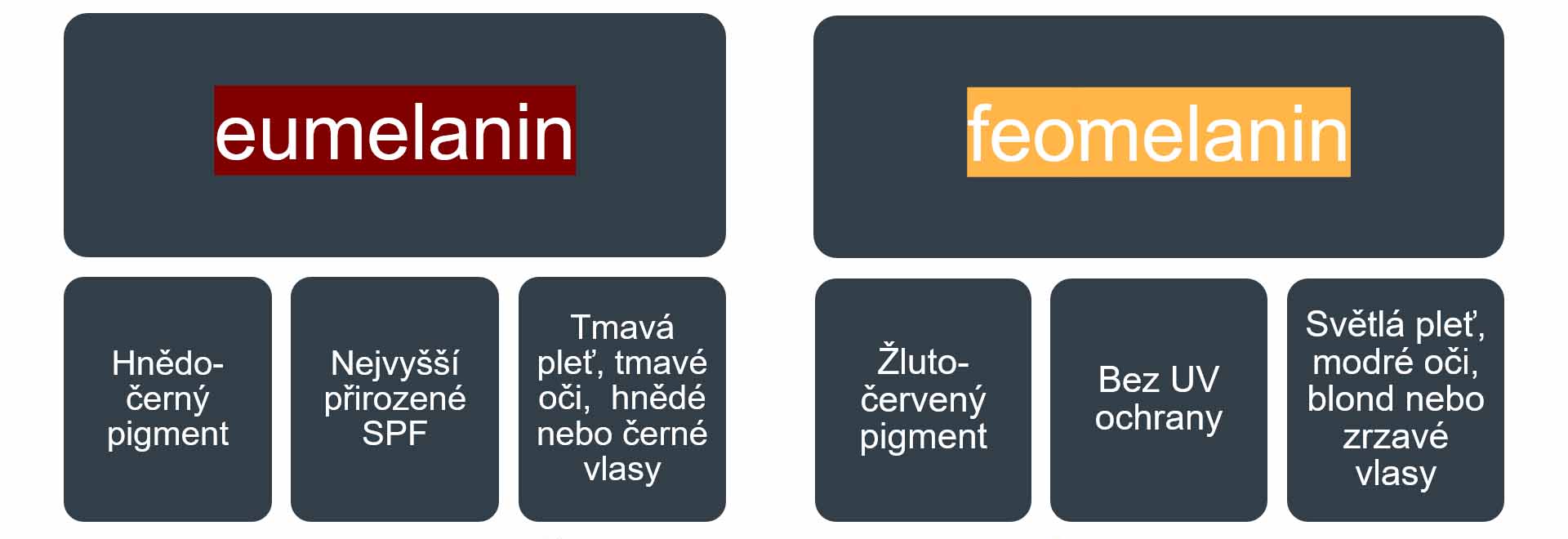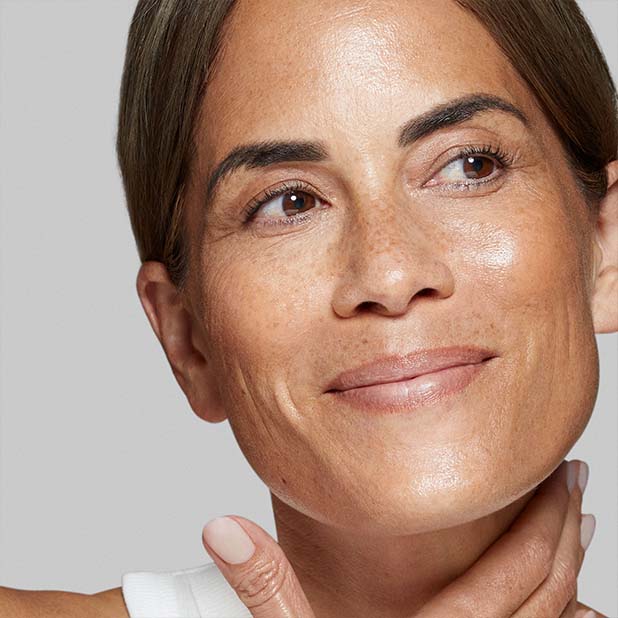How to get rid of dark spots?
That stubborn pimple mark on your face just won’t go away? Or after returning from vacation, are you spotting far more dark spots on your skin? You might be dealing with hyperpigmentation—excessive melanin production. We’ll explain why it occurs and what actually works on pigmentation spots.

Skin visibly affected by hyperpigmentation
What are pigmentation spots?
Pigmentation spots are small areas of skin with darker coloring. They’re caused by melanin—a pigment produced by pigment cells called melanocytes. Melanin protects the skin from UV radiation and damage and determines its tone. When cells overproduce it in a certain area, dark spots appear. That’s why this is commonly called hyperpigmentation—excessive pigmentation.
We distinguish two main types of melanin: pheomelanin, responsible for lighter skin tones, and eumelanin, which contributes to darker shades. In lighter skin types, hyperpigmentation may appear as red or pink spots; in darker complexions, as brown, black, or purplish spots.

How and why do pigmentation spots develop?
There are many reasons why melanin production increases—and many of them you can influence yourself:
- Sun exposure: “Up to 80% of visible skin changes are caused by UV radiation,” says MUDr. Barbora Jankovičová from the Skin Prevention Center in Olomouc, adding: “Ultraviolet rays stimulate melanocytes and over time damage them. That leads to irregular or excessive pigment production.”
- Hormones: Some types of hyperpigmentation, such as melasma, are related to elevated hormone levels (e.g., during pregnancy or puberty).
- Genetics: A genetic predisposition also determines the likelihood of hyperpigmentation.
- Medications: Dark spots can also be triggered by some combinations of drugs, certain antibiotics, or the use of hormonal contraception.
- Skin inflammation: Post-inflammatory hyperpigmentation is common—pigmented spots appear after acne or other skin damage.
- Pollution: Dark spots can also result from airborne particles in polluted air penetrating the skin.
Types of pigmentation spots
There are several types of hyperpigmentation. Here are the most common:
- Melasma: Usually affects the face and is driven by hormones. It's often called the “pregnancy mask.” After childbirth, the spots sometimes fade on their own.
- Post-inflammatory hyperpigmentation: Can appear anywhere on the body after acne, eczema, or other inflammation or skin injury.
- Age spots: Also known as sun spots or liver spots, they most commonly appear in sun-exposed areas like the face, décolleté, or hands.
Did you know… pigmentation spots and freckles are not the same? “Freckles are genetic and appear in childhood. In the summer (after sun exposure) they darken; in winter they may lighten,” explains MUDr. Barbora Jankovičová.
Pigmentation spots, on the other hand, usually emerge in adulthood as a result of chronic skin damage, and unlike freckles, they don’t disappear or fade in winter.

Pigmentation and age
If you feel that hyperpigmentation becomes more noticeable with age, it's not just your imagination. The main reason is UV exposure. “We are exposed to the sun our entire lives, and its effects add up,” says MUDr. Barbora Jankovičová. At the same time, melanocytes begin to work irregularly over time, and skin renewal slows down. All of which makes spots more pronounced.
How to prevent hyperpigmentation?
Prevention won’t work for every type of hyperpigmentation, but often following basic guidelines helps:
- Avoid direct sun exposure, especially during peak hours (approximately 11 a.m. to 3 p.m.).
- Use sun protection every day—at least SPF 30.
- Shield yourself from sun rays with hats or long sleeves.
- As tempting as it is, avoid popping pimples or picking at scabs.
How to treat pigmentation spots: home remedies and professional methods
Good news: even if dark spots appear, there are solutions. Some tips you can try at home; others require professional intervention.
Care with the right ingredients
In creams and serums (try, for example, PowerBright Dark Spot Serum), look for ingredients like vitamin C, salicylic acid, glycolic acid, or retinol, which support skin renewal. Oligopeptides, zinc glycinate, or niacinamide help regulate melanin production.
Exfoliation
Regular removal of dead skin cells with gentle chemical or mild mechanical exfoliants also helps lighten spots. Try a peel for reducing hyperpigmentation, such as PowerBright Dark Spot Peel.
Professional cosmetic treatments
Effective removal of pigmentation spots can also be achieved with professional methods like chemical peels or IPL (intense pulsed light). A professional in a salon can recommend the best strategy.
Medications
Certain medications may help, too. In this context, corticosteroids are often mentioned—but it's more complex. “Corticosteroids do not work on regular pigmentation spots and do not remove existing pigmentation,” says MUDr. Barbora Jankovičová, adding: “The exception may be post-inflammatory hyperpigmentation, e.g., after acne, where steroid use may reduce the risk of pigmentation by addressing inflammation early.”
Home remedies
You may also find DIY treatments using lemon juice, apple cider vinegar, or plain yogurt for their supposed lightening effects. But it’s good to remember that their efficacy isn’t proven, and they may even cause skin irritation.
And the most important advice at the end: be patient. With consistent care, you'll see initial results in about a month, and up to 75% fading may take four months or longer. So stay diligent and don’t give up too soon.

